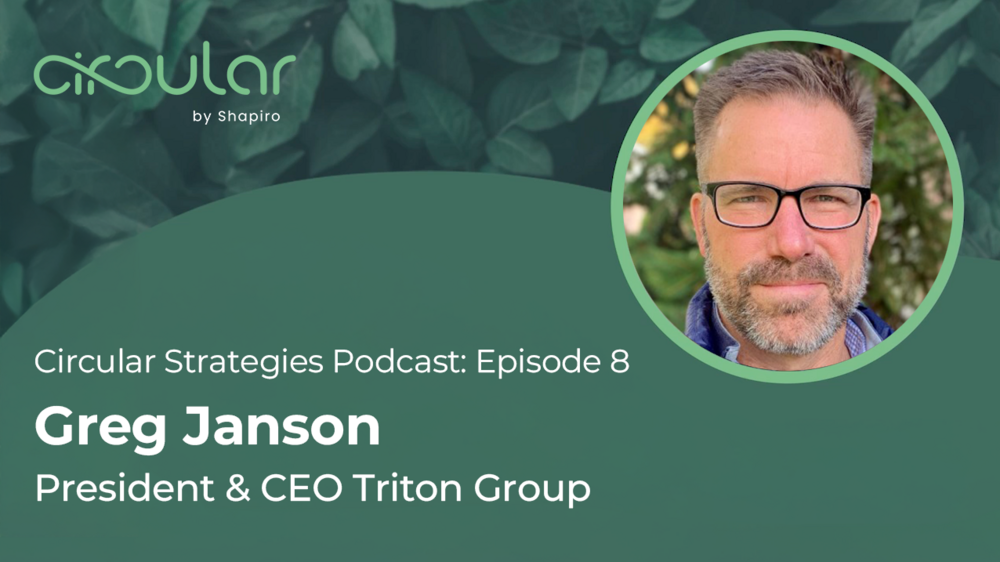Circular Strategies Podcast
Circular Strategies Podcast: Episode 8 with Greg Janson of Triton Ties
 Circular Strategies Podcast
Circular Strategies Podcast
September 12, 2025

Greg Janson: Engineering Circular Solutions from Plastic Waste to Railroad Ties
In this episode of the Circular Strategies Podcast, host Bob Alvarez speaks with Greg Janson, President of Triton Ties, whose career spans a childhood in a family recycling yard, leadership in the Marine Corps, and decades building (and rebuilding) recycling businesses. Greg’s through-line: turn waste into durable value by aligning environmental impact with hard, bottom-line economics.
Raised around scrap and paper recovery, Greg watched the industry evolve—and felt the shocks when it didn’t. After scaling plastic recovery facilities, the team hit a wall as cheap virgin resin flooded the market. The lesson stuck: plastic recycling won’t scale on hope and spot pricing. It scales when you design products and contracts that make durability and economics work together. Enter composite railroad ties built from post-consumer plastics.
What You’ll Learn in This Episode
From Scrap Yard to Systems Thinking
How growing up in recycling (and later, Marine Corps leadership) shaped Greg’s practical, map-in-hand approach to strategy, logistics, and servant leadership.
Why Plastic Markets Break Without Contracts
Paper had long-term mill contracts; plastics didn’t. Greg explains how the lack of floor-price, multi-year offtake deals makes it nearly impossible to finance recycling capacity and how to fix it.
Why Triton Ties targeted a problem with clear economics: wood ties degrade quickly in high-rot zones, driving costly replacements. A durable alternative can save hundreds of thousands of dollars per mile over a tie’s life.
Engineering “Real Recycling”
First-gen “plastic ties” failed because they weren’t true composites. Triton Ties reinforces mixed-olefin plastics with glass fiber to achieve wood-like strength without rot—optimized for 50+ year performance and one-for-one replacement alongside wood.
How a Bottle Becomes a Tie
A clear, step-by-step look at the process: sourcing large mixed rigids → size reduction → magnets & washing → float/sink separation (olefins float) → regrind → additives (e.g., UV carbon black) + glass fiber → molding → X-ray QC and batch testing.
Lifecycle Economics Over “Perfect Circles”
Greg argues for “real recycling”: use post-consumer plastics to replace inferior legacy materials (like rot-prone wood) rather than forcing packaging back into identical packaging. Circularity can be oblong and still be the strongest loop.
Beyond Ties: Where Plastics Win Next
Industrial durables that can absorb high volumes of recycled resin—pallets, marine structures, infrastructure components—especially when reinforced and designed for long life.
Greg’s ten-year vision: multi-plant capacity, long-term offtake with Class I railroads, and a nationwide network of trained recyclers supported by guaranteed homes and floor prices—finally making the economics of plastic recycling bankable.
Why This Conversation Matters
If sustainability can’t survive a CFO’s red pen, it won’t scale. Greg lays out a practical blueprint: engineer products for durability, align with a customer’s real problem, and underpin the system with long-term contracts. That’s how we move from sporadic “wins” to infrastructure-level circularity.
🎥 Watch the full conversation above to hear Greg’s candid lessons—from hard resets to new generation composites—and see how “recycling the genius of plastics” can deliver results that last.
You can find out more about Triton Ties: https://www.tritonties.com/
